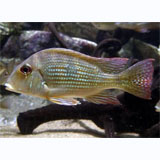
Scientific Name: Geophagus surinamensis
Origin: South America
Family: Cichlidae
Other Names: Redstripe Eartheater
Technical Info
Temperature: 22 - 26 ℃
pH: 6.8 - 7.2
GH: 6 - 10
Max size: 24 cm
Min Tank size: 300 Ltr
Position in Aqua: No special swimming level
Description
G. Surinamensis is a peaceful, relatively non-territorial cichlid, with beautiful, almost iridescent patterns of blue, green and red markings. As their common name suggests, they are ferocious diggers, foraging constantly for food in the substrate. They are well designed for this, with a long, sloping forehead and eyes placed high on their head. They are slower growing than a lot of other SA cichlids and it does take them a while to get to adult size.
Food
Feed varied sinking foods as these fish will only feed from the bottom of the tank. It should feature a lot of vegetable material as well as small invertebrates like daphnia or brine shrimp. High quality sinking Cichlid pellets are also beneficial.
Breeding
The Red striped earth eater or by its scientific name Geophagus surinamensis reach to maturity at age of 1 year. It is not so hard to sex between male and female Geophagus surinamensis. Males develop long extensions on their fins while these extensions are much smaller or not exist at all in females. The Red striped earth eater is a mouthbrooder. The Preferred spawning site is on a flat stone, the female will take the unfertilized eggs in her mouth, and eggs will be fertilized after the male release his milt into her mouth. This process occurs when the female follow the male very close to his anal fin, the male have spots on this fin, those spots known as dummy eggs, the female believes these are more eggs and goes to catch them this is the right moment for the male to release his milt. In this species either parent will take the fertilized eggs in their mouth and hold them for 3-4 days until hatching. Fry can be fed with newly hatched brine shrimp or with liquid fry food.
Compatible with
A generally peaceful larger Cichlid which should not bother smaller fish. Keep with equally peaceful South American Cichlids and can also be kept with Tetras and Corydoras. Should not be kept with more territorial and aggressive fish such as Oscars as these fish will feel threatened and spend most of their time hiding.





